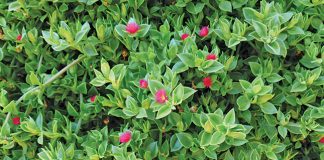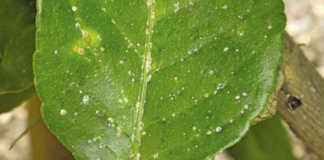In South Africa at present, only Spanish-type groundnuts are cultivated as they are best adapted to local conditions. The newly registered Tufa cultivar is a good example. Groundnuts form flowers on fruiting branches above the soil. After fertilisation of the flower, a ‘peg’ – an elongated ovarian structure – enters the soil and pods develop from its tip. Spanish types grow upright with sequential branches, which means the pods are borne close to the main stem. The pods contain one or two tan-coloured seeds.
For high-yielding, healthy groundnuts, follow these basic guidelines:
Crop rotation
Plant groundnuts only once in four years on the same land. Crop rotation sustains soil health and aids in disease control, and can be adopted by both subsistence farmers and commercial producers.
Soil requirements
Groundnuts should preferably be grown in sandy soils. This allows for easy harvesting and minimises yield losses.
Planting date
Soil temperature is important in determining the planting date of groundnuts. If it drops below 15°C, groundnut germination ceases and herbicide damage may occur. To ensure germination, a minimum soil temperature of at least 18°C is necessary. Groundnuts should be planted between 30 October and 9 December.
Spacing and planting depth
It’s important to treat seeds with registered fungicides before sowing in order to prevent seedling blight caused by bacteria and fungi. Treating seeds with thirum, provided it is done thoroughly, has been shown to give adequate protection. Plants should be spaced 7,5cm apart in the rows and planted at a depth of no more than 7cm. Rows should be about 90cm apart, but this can be adjusted depending on soil moisture and other factors.
Planting
The seedbed should be flat and fine. The seeds should be planted slowly. In fact, a golden rule is: never move implements at high speed on the land during planting, weeding and harvesting.
Weed control
Groundnuts cannot compete with weeds, particularly during the early developing stages. Pre- and post-emergence herbicides may be used, but are expensive. Weed by hand, but when pegging begins, avoid piling up earth around the peg so as not to disturb pod development.
Disease control
Groundnuts are susceptible to several foliar diseases, so frequent inspections are important. As mentioned, fungicides and crop rotation can play a major role in controlling disease.
Harvest date
To ensure both optimal yield and highest quality, it is crucial to harvest at the right time. As a guide, if 70% of the pods in a sample are mature, harvesting should proceed. Pods are mature when the hulls turns dark on the inside or shows a dark colour when scraped on the outside.
Contact Loureine Salomon on 018 299 6333 or email [email protected].













